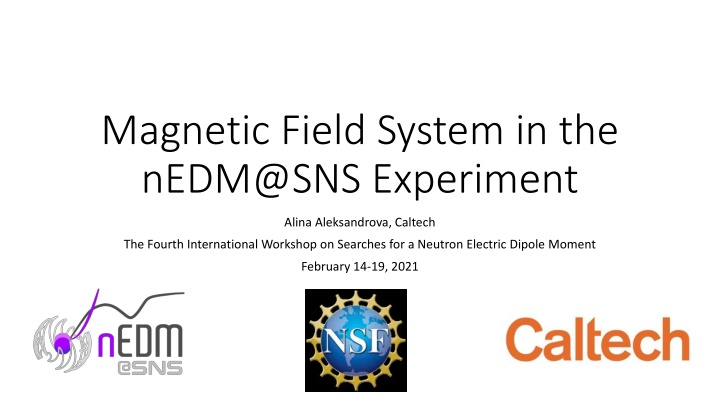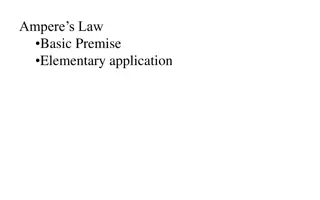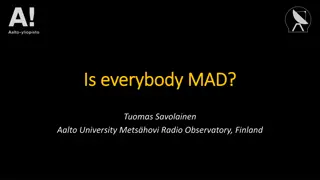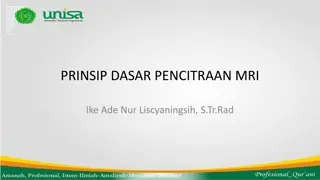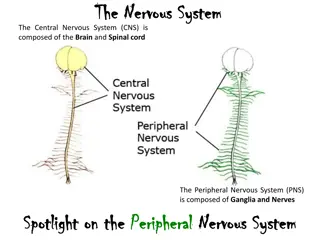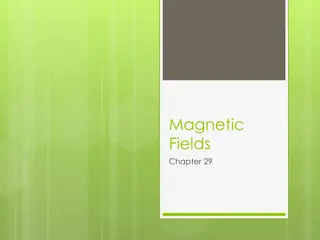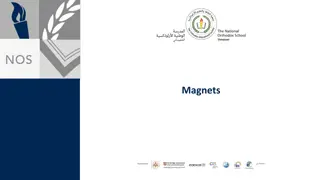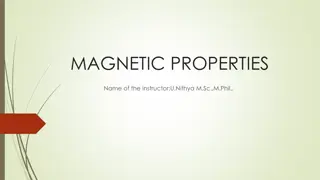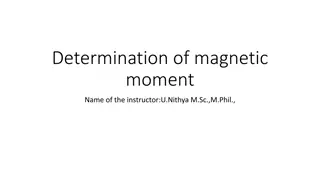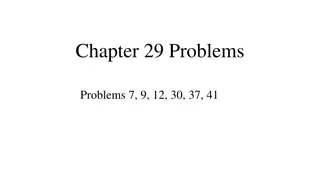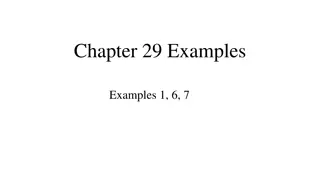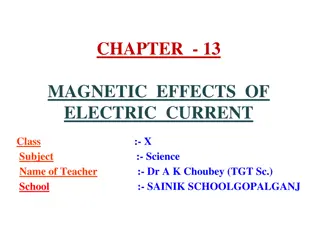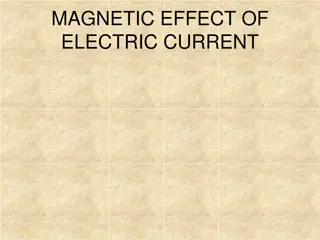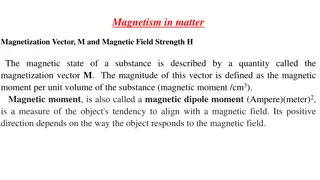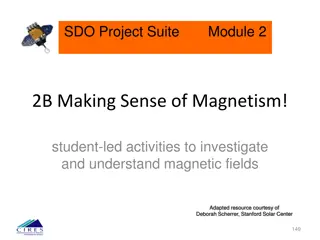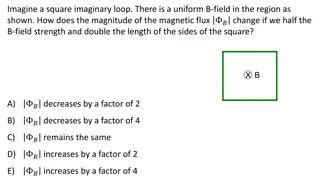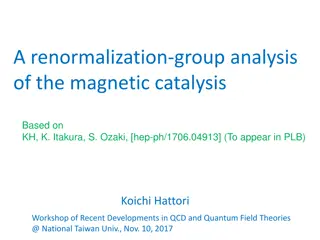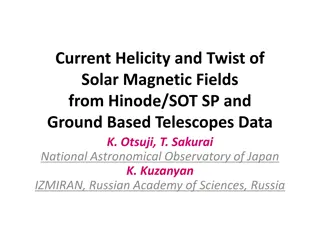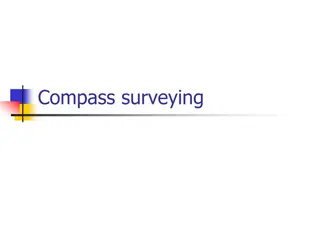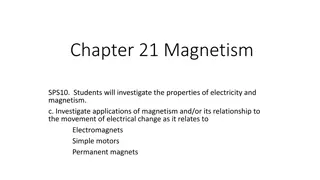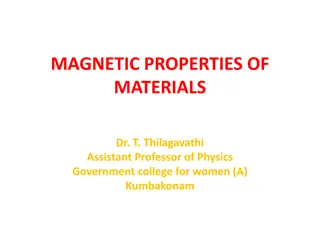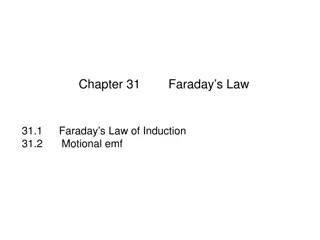Magnetic Field System in the nEDM@SNS Experiment
The presentation discusses the magnetic field system requirements, layout, and components for the nEDM@SNS experiment, highlighting the importance of coil uniformity, shielding, and superconducting materials to achieve accurate measurements of neutron electric dipole moments.
Uploaded on Sep 18, 2024 | 3 Views
Download Presentation

Please find below an Image/Link to download the presentation.
The content on the website is provided AS IS for your information and personal use only. It may not be sold, licensed, or shared on other websites without obtaining consent from the author.If you encounter any issues during the download, it is possible that the publisher has removed the file from their server.
You are allowed to download the files provided on this website for personal or commercial use, subject to the condition that they are used lawfully. All files are the property of their respective owners.
The content on the website is provided AS IS for your information and personal use only. It may not be sold, licensed, or shared on other websites without obtaining consent from the author.
E N D
Presentation Transcript
Magnetic Field System in the nEDM@SNS Experiment Alina Aleksandrova, Caltech The Fourth International Workshop on Searches for a Neutron Electric Dipole Moment February 14-19, 2021
Outline Part 1: Magnetic Field Requirements Part 2: Magnet System Layout Part 3: Building the Magnet Part 4: Building the Shields A. Aleksandrova 2
PART 1: Requirements A. Aleksandrova 3
Magnetic Field Requirements: B0 Coil: Holding field 3 T Uniformity of 3 ppm/cm transverse coherence time T2 of UCN and 3He limit false nEDM systematics < 1.5 x 10-28 e-cm from geometric phase effect Dressing Coil: AC field of < 50 T Uniformity of 5 ppm/cm used to dress UCN and 3He spins used as ?/2 spin flip A. Aleksandrova 4
PART 2: Magnetic Field System Layout A. Aleksandrova 5
Cross Section View of the Inner Magnet Volume (IMV) Pb End Cap IMV Cooling Loops Pb End Plate Pb Side Shield Metglas Cloaks IVC Wall Metglas Flux Return B0 Coil Cu AC Field Shield Center Axis Dressing Coil Figure credit: W. Wei A. Aleksandrova 7
B0 Coil: (Superconducting Cu-clad NbTi wire) 3 T and uniformity of 3 ppm/cm uniformity is crucial for the transverse coherence time T2 of UCN and 3He Dressing Coil: (Superconducting Sn/Pb Solder Wire) AC field < 50 T and uniformity of 5 ppm/cm also used as ?/2 spin flip Shim & Gradient Coils: (SC NbTi wire) DC fields: Cos Solenoid, Gradientswound on dressing coil B0 Flux Return: Metglas 2826M, location accuracy < 1 mm improve field uniformity, mitigating the effect of errors in wire placement and reducing field distortions due to the cylindrical superconducting Pb shield Superconducting Pb Shield: Further shield the ambient environmental magnetic fields and stabilize magnetic drifts over the measurement time AC Field Shield: A copper film shields the Megtlas from eddy-current heating due to dressing field Not to scale ???? Coils Bdressing E E B0 UCN Cells Neutron Beam Slide credit: W. Wei A. Aleksandrova 8
Schematic of Cooling System LN2 shield IMV cooling loops A. Aleksandrova 9 Slide credit: W. Wei
PART 3: Building the Magnet A. Aleksandrova 10
Wire Tensioners The challenges: It s really, really big! We have to use nonmagnetic components! Thermal contraction! Hoops ~2.3m B0 Coil Space Frame Story Stick Stiffening Gussets A. Aleksandrova 11 ~2m
B0 Hoops: Each hoop is composed of segments. The segments are water jet cut from a sheet of G10-CR. B0 hoop The glued components are vacuum pressed for 7 days to ensure adhesion. Top layer Bottom layer DP190 epoxy is used to glue the top and bottom hoop layers. A. Aleksandrova 12
Cooled down to 90K/87K The glued hoops are cold tested several times. A. Aleksandrova 13
Assembling the space frame Story stick B0 hoop gusset A. Aleksandrova 15
B0 Coil Torlon pulley system 0.5 mm PEEK spring superconducting Cu-clad NbTi wire Boss ring Wire slots A. Aleksandrova 16
West East West T (K) East time A. Aleksandrova 17
Dressing Coil Space frame structure is similar to the space frame of the B0 magnet. Superconducting SnPb (50/50) solder wire. Want to minimize heating Wire guides A. Aleksandrova 18
PART 4: Building the Lead Shield A. Aleksandrova 19
Superior Lead End Cap (SLEC) Cross Section View of the Inner Magnet Volume (IMV) Pb End Cap IMV Cooling Loops Lead End Cap (LEC) Pb End Plate Pb Side Shield Metglas Cloaks IVC Wall Metglas Flux Return B0 Coil Cu AC Field Shield Lead layer (1/32 thick) Center Axis G10 layers Dressing Coil A. Aleksandrova 20
90x90x1/32 lead sheet G10 hoop DP190 epoxied to lead ring. Vacuum pressing of G10 to lead. Wire slot Hardware slot for gusset support. Story stick slot A. Aleksandrova 21
Other shields SLEC Superconducting Pb shield 0.8mm thick Pb barrel Supported by a cylindrical G10 shell Pb segment Pb bridge B0 LEC SD LEC Meglas flux return 2826M, 29 m thick Supported by a G10 skin Tension block G10 skin Cu shield Cu (34 m) clad G10 skin Tube Mandrel Tension bolt hoop A. Aleksandrova 22
Ongoing work We are in the process of finishing the space frame of the magnet. Finish magnet assembly and winding ~ May Test magnet at Caltech Ship magnet to ORNL for P/T tests 2022 A. Aleksandrova 23
SNS nEDM Collaboration New Members: R. Tat, Caltech U. Coskun, Kentucky G. Riley, LANL T. Z. Martinez, UNAM M. Morano, NCSU C. Hickman, NCSU. J. Vanderwerp, Indiana M. Luxnat, Indiana J. Koivuniemi, Illinois A. Aleksandrova 24
Extra Slides A. Aleksandrova 25
Measured Data Reconstruction By [mG] Bz [mG] Bx [mG] 2 - 3 - 2 - 1 - 32 33 34 35 0 2 0 20 - 15 - 10 - 20 - 15 - 10 - 20 - 15 - 10 - 5 - 5 - 5 - x [cm] x [cm] x [cm] 0 0 0 5 10 15 20 5 10 15 20 5 10 15 20 By [mG] Bz [mG] Bx [mG] 0.5 1.5 0.5 1.5 30 32 33 31 0 1 1 20 - 15 - 10 - 20 - 15 - 10 - 20 - 15 - 10 - Component (mG/cm) Measured Data Reconstruction 5 - 5 - 5 - y [cm] y [cm] y [cm] 0 0 0 5 10 15 20 5 10 15 20 5 10 15 20 dBx/dx -0.035 -0.032 By [mG] -0.081 Bz [mG] Bx [mG] dBx/dy 29 -0.081 1.5 - 0.5 - 0.5 - 0.5 1 - 1 - 28 30 32 31 0 0 15 - 15 - 15 - 10 - 10 - 10 - dBx/dz 0.087 0.089 5 - 5 - 5 - z [cm] z [cm] z [cm] 0 0 0 5 5 5 10 10 10 15 15 15 A. Aleksandrova 26
